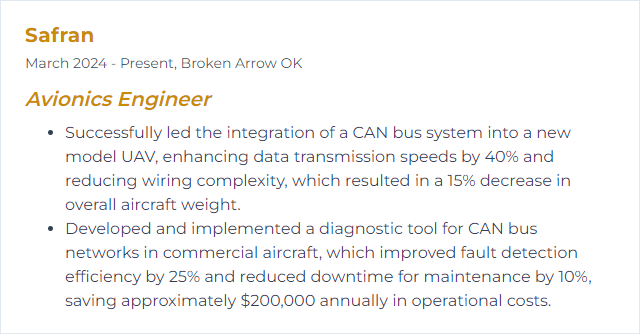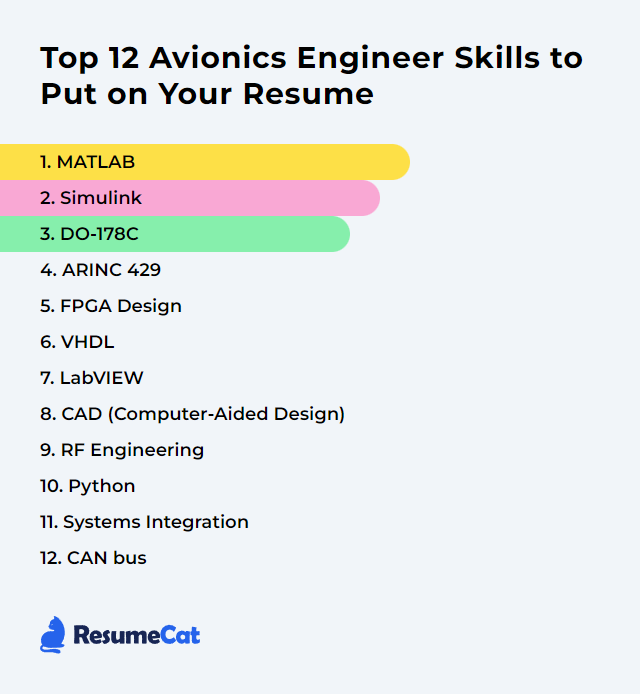Top 12 Avionics Engineer Skills to Put on Your Resume
Avionics engineering lives in the details. Hiring teams scan for proof you can model, verify, and stitch complex systems together without blinking. Below you’ll find twelve essential skills employers expect—and how to sharpen them so your resume lands with authority.
Avionics Engineer Skills
- MATLAB
- Simulink
- DO-178C
- ARINC 429
- FPGA Design
- VHDL
- LabVIEW
- CAD (Computer-Aided Design)
- RF Engineering
- Python
- Systems Integration
- CAN bus
1. MATLAB
MATLAB is a high-level environment for numerical computing and algorithm development. Avionics engineers lean on it for modeling, data analysis, controls, and simulation across flight dynamics and embedded workflows.
Why It's Important
It accelerates analysis and design of safety-critical functions. You can model a control loop, poke at edge cases, validate performance, then feed results into verification—fast and traceable.
How to Improve MATLAB Skills
- Lock down fundamentals: vectors, matrices, data types, control flow, file I/O. Faster work, fewer bugs.
- Lean on toolboxes: Control System, Signal Processing, Aerospace, Optimization. They save months.
- Push into Simulink co-development: Create plant models, run closed-loop simulations, and export artifacts for verification.
- Write efficient code: preallocate, vectorize, profile hotspots, use tall arrays and parallel computing when needed.
- Automate testing: scripts for regression runs, unit tests for algorithms, coverage checks.
- Bridge to hardware: real-time targets, data acquisition, and HIL to close the loop on benches.
- Document and version: live scripts for traceability, Git for changes, reviews for sanity.
How to Display MATLAB Skills on Your Resume
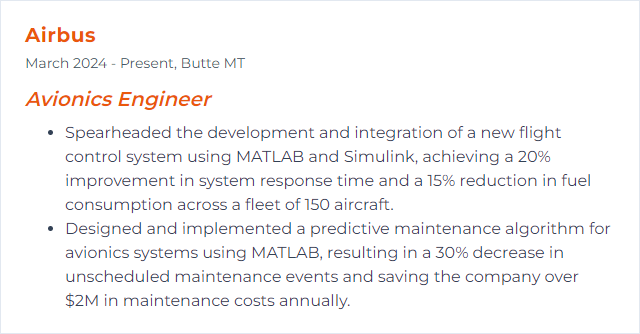
2. Simulink
Simulink is a graphical environment for modeling and simulating dynamic systems. In avionics it anchors model-based design for controls, guidance, communication, and signal chains.
Why It's Important
It lets you explore architectures, catch faults early, and generate artifacts that flow into verification and certification. Less guesswork, more evidence.
How to Improve Simulink Skills
- Adopt model-based design: requirements-to-model traceability, iterative simulation, and automated tests.
- Use domain libraries: Aerospace Blockset, Navigation, and control blocks that reflect real vehicle physics.
- Keep models lean: fixed-step solvers where appropriate, rate transition hygiene, partitioning for reuse.
- Speed up runs: accelerator modes, parallel simulations, data logging only where it matters.
- Harden with testing: test harnesses, scripted test suites, coverage, and property checks.
- Treat models like code: version control, model diffs, model reviews, and curated libraries.
How to Display Simulink Skills on Your Resume

3. DO-178C
DO-178C is the cornerstone guidance for airborne software approval. It specifies objectives, evidence, and rigor by Design Assurance Level (DAL), with supplements covering model-based development (DO-331), formal methods (DO-333), object-oriented technology (DO-332), and tool qualification (DO-330).
Why It's Important
It’s the language certification authorities speak. Aligning plans, requirements, code, tests, and traceability to DO-178C is how avionics software gets approved to fly.
How to Improve DO-178C Skills
- Start with planning: PSAC, SDP, SVP, SQAP, SCMP—solid plans and early agreement reduce thrash.
- Write testable requirements: clear, unambiguous, and measurable. Trace them straight into test cases.
- Qualify tools when needed: establish confidence for any tool that replaces or verifies manual activities.
- Embrace MBSE and MBD: models are great, but only with bi-directional traceability and reviewable artifacts.
- Test deeply: structural coverage to required levels (up to MC/DC), robustness tests, independence where mandated.
- Control configuration: baselines, change records, and reproducible builds for every certified drop.
- Review relentlessly: independent reviews for requirements, design, code, and tests. Catch defects upstream.
- Measure and improve: defect trends, coverage metrics, schedule fidelity; tune the process continuously.
How to Display DO-178C Skills on Your Resume
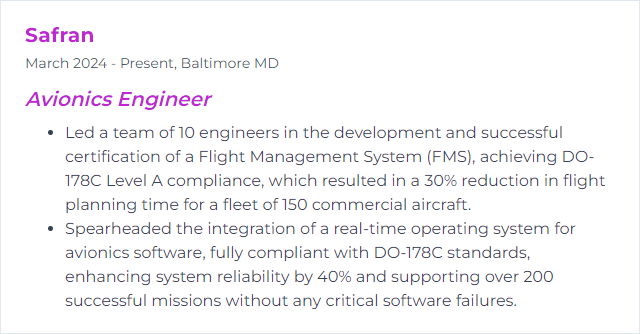
4. ARINC 429
ARINC 429 defines a two-wire, unidirectional point-to-point data bus with standardized word formats, labels, and signaling. It’s the stalwart backbone for many avionics systems.
Why It's Important
Interoperability. Predictable timing. Simple and robust wiring that plays nicely across mixed-vendor equipment.
How to Improve ARINC 429 Skills
- Design for the bus: respect loading limits, word gaps, and cable lengths; keep stubs short and terminations correct.
- Use the right speed: choose low speed (12.5 kbps) or high speed (100 kbps) based on latency and throughput needs.
- Manage labels well: map, document SSM/SDI usage, and enforce ICDs to avoid collisions and misinterpretation.
- Bridge wisely: when mixing with AFDX (ARINC 664), CAN, or MIL‑STD‑1553, ensure gateways preserve timing and integrity.
- Test on the wire: validate with bus analyzers, fault injection, and long-run soak tests to catch edge cases and noise issues.
- Build in redundancy: dual channels and fault detection to keep data flowing under failures.
How to Display ARINC 429 Skills on Your Resume
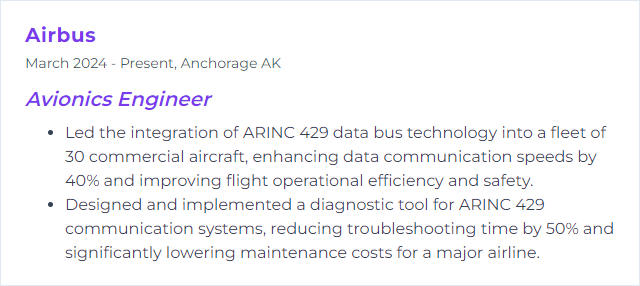
5. FPGA Design
FPGAs deliver deterministic, parallel hardware for time-critical avionics functions: sensor fusion, interface bridging, signal processing, and safety monitoring.
Why It's Important
They bring speed and reconfigurability without a full ASIC cycle. Perfect for certified, low-latency paths where software alone can’t keep up.
How to Improve FPGA Design Skills
- Follow DO-254 discipline: requirements, design reviews, traceability, and verification evidence for airborne hardware.
- Architect modularly: clean interfaces, parameterized IP, clock domains decoupled and documented.
- Tame timing: constrain clocks properly, manage CDC with synchronizers/FIFOs, and analyze slack with rigor.
- Simulate wide and deep: unit, integration, and gate-level as needed; assertions and coverage to close the loop.
- Optimize resources: balance LUTs, BRAM, DSP slices, and power; pipeline aggressively where latency allows.
- Harden for reliability: ECC for memories, TMR where warranted, reset strategy that actually resets.
- Automate: scripted builds, linting, static timing reports, and continuous integration.
- Tooling currency: keep flows current (e.g., AMD Vivado, Intel Quartus) and align versions with project baselines.
How to Display FPGA Design Skills on Your Resume
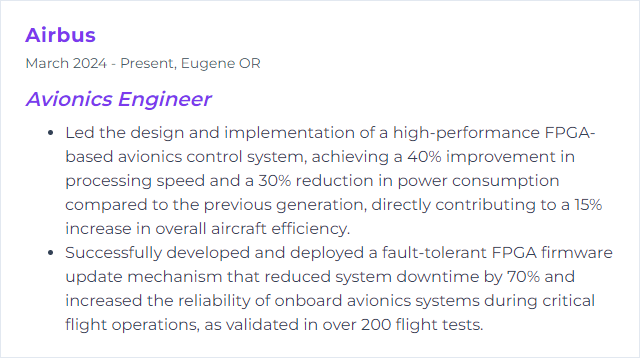
6. VHDL
VHDL models and implements digital logic for FPGAs and ASICs. It’s the lingua franca for deterministic avionics hardware.
Why It's Important
Strong, typed, and crystal-clear when done right. VHDL supports rigorous design, simulation, and certification evidence.
How to Improve VHDL Skills
- Use modern VHDL: VHDL‑2008 features (generics, fixed/flt packages, cleaner syntax) make designs safer and shorter.
- Adopt verification frameworks: OS‑VVM or UVVM for constrained random, scoreboards, and coverage.
- Write for readability: consistent naming, reset conventions, and synthesizable templates for common patterns.
- Test first: build self-checking testbenches with assertions; simulate for corner cases and CDC boundaries.
- Lint and review: static checks and peer reviews to catch latch inference, unintended combinational loops, and hazards.
- Package IP: reusable components, clean generics, and thorough docs for faster integration.
How to Display VHDL Skills on Your Resume
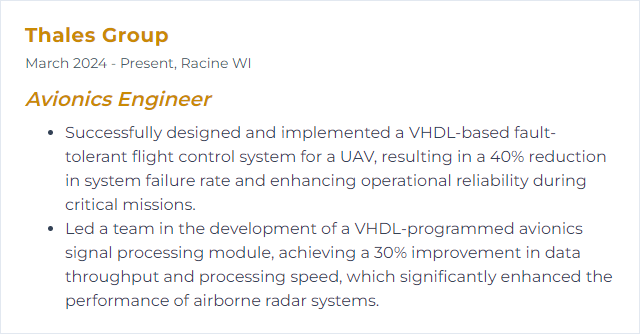
7. LabVIEW
LabVIEW enables graphical development for test, measurement, and control. In avionics labs, it powers benches, HIL rigs, data acquisition, and rapid diagnostics.
Why It's Important
It bridges hardware and software quickly. You can stand up test automation, log mountains of data, and close verification gaps without reinventing tooling.
How to Improve LabVIEW Skills
- Master dataflow: queues, events, and producer–consumer templates to keep UIs snappy and tests deterministic.
- Structure projects: use project libraries, typedefs, and versioned reuse libraries; manage dependencies via package managers.
- Automate tests: unit testing frameworks, CI hooks, and reproducible deployments for benches.
- Go real-time and FPGA: deterministic loops for timing-critical tasks; offload to FPGA when deadlines are tight.
- Instrument drivers: standardize VISA/DAQ interfaces, error clusters, and logging so teams can share modules.
- Profile and debug: probes, highlight execution, and performance tools to chase race conditions and bottlenecks.
How to Display LabVIEW Skills on Your Resume
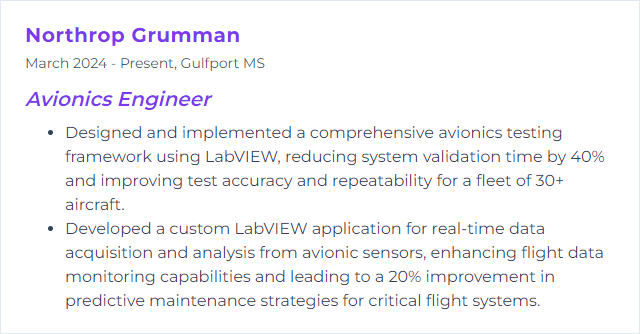
8. CAD (Computer-Aided Design)
CAD spans both MCAD and ECAD for avionics: mechanical packaging, harnesses, PCB layout, and 3D integration across tight spaces and stricter-than-strict constraints.
Why It's Important
You’ll pack heat-dissipating electronics into unforgiving volumes while meeting weight, cooling, vibration, and maintainability targets. Good CAD keeps assemblies buildable and certifiable.
How to Improve CAD (Computer-Aided Design) Skills
- Learn the full stack: schematic capture, PCB layout, 3D enclosure, and harness design with MCAD–ECAD co-design.
- Design for compliance: EMC/EMI practices, creepage/clearance, grounding, and thermal paths aligned with DO‑160 environments.
- Standardize libraries: vetted footprints, materials, fasteners, and stackups to reduce rework.
- Simulate early: mechanical interference checks, thermal analysis, and signal integrity on critical nets.
- Document for production: BOMs, fab/assembly drawings, exploded views, torque specs, and revision control.
- Think maintainability: access to connectors, strain relief, labeling, and modularity for quick swaps.
How to Display CAD (Computer-Aided Design) Skills on Your Resume
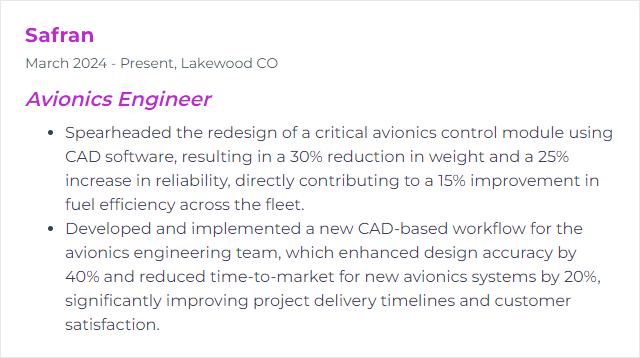
9. RF Engineering
RF Engineering covers radios, navigation aids, radar, antennas, and the gnarly physics between them. Everything rides on clean spectrum use and resilient links.
Why It's Important
Aircraft need reliable comms and navigation despite interference, motion, and weather. RF design makes or breaks those links.
How to Improve RF Engineering Skills
- Strengthen fundamentals: propagation, link budgets, noise figures, filters, mixers, and nonlinearity behavior.
- Design the antenna first: placement, ground planes, cable losses, and co-site interference mitigation.
- Model and measure: EM simulation for critical structures, then VNA/spectrum analyzer sweeps to validate.
- Harden for the aircraft: shielding, bonding, lightning protection, and DO‑160 EMI/EMC compliance strategies.
- Manage coexistence: intermod studies, filtering plans, and dynamic range budgeting across all onboard emitters.
- Log, then iterate: flight test data, channel impairments, and closed-loop adjustments to tighten margins.
How to Display RF Engineering Skills on Your Resume
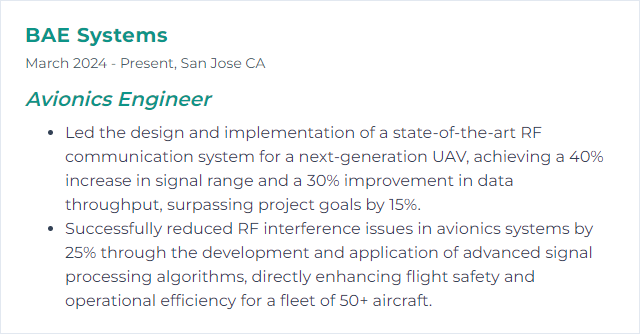
10. Python
Python powers analysis, automation, test orchestration, data pipelines, and quick-turn tooling across avionics programs.
Why It's Important
It’s fast to write, easy to maintain, and rich with libraries. Perfect for wrangling logs, controlling instruments, and validating performance at scale.
How to Improve Python Skills
- Own the core: clean functions, typing where it helps, PEP 8 style, and robust error handling.
- Use the scientific stack: NumPy, pandas, SciPy for math and data; matplotlib or seaborn for crisp plots.
- Automate testing: pytest, fixtures, and coverage tied into CI. No silent regressions.
- Talk to hardware: PyVISA, PySerial, and socket interfaces for benches and HIL rigs.
- Package your tools: virtual environments, dependency pins, and simple CLIs; ship once, run anywhere.
- Speed where it counts: vectorize, cache, or drop into numba/Cython when performance bites.
How to Display Python Skills on Your Resume
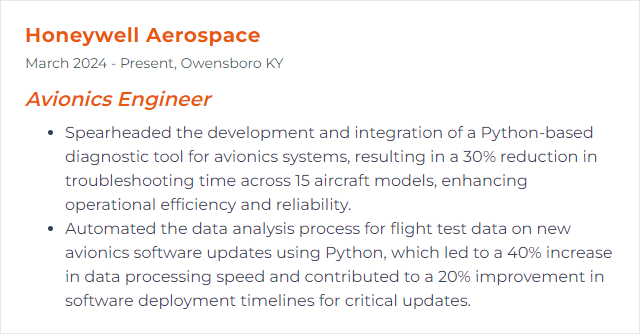
11. Systems Integration
Systems integration blends navigation, comms, displays, flight controls, sensors, and power into one aircraft-ready whole. Clean interfaces, relentless testing, and traceability hold it together.
Why It's Important
Safety and performance depend on subsystems behaving as one. Integration transforms good parts into a reliable aircraft system.
How to Improve Systems Integration Skills
- Start with the right frameworks: ARP4754A for systems engineering and ARP4761 for safety flow through the lifecycle.
- Nail requirements and ICDs: precise interfaces, timing budgets, and data mappings prevent chaos later.
- Model with intent: MBSE (e.g., SysML) for architecture; couple models to verification plans.
- Integrate in layers: SIL first, then HIL, then iron bird and aircraft. Prove assumptions at each gate.
- Automate CI/CD: hardware-aware test rigs, simulation farms, and pipelines (e.g., GitHub Actions or GitLab CI) to keep builds green.
- Respect data buses: ARINC 429/664, CAN/ARINC 825, and MIL‑STD‑1553 with gateways that preserve determinism.
- Close the loop on safety: FMEA/FTA outputs drive tests, monitors, and fault injection scenarios.
How to Display Systems Integration Skills on Your Resume
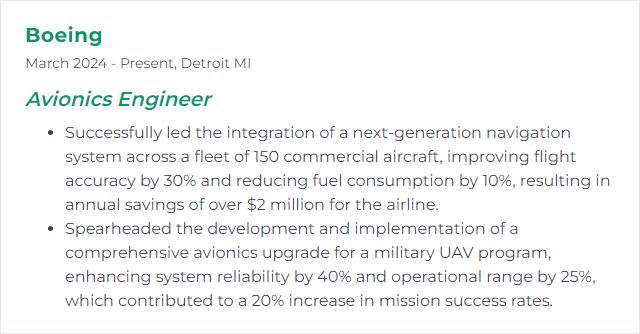
12. CAN bus
CAN bus links controllers and devices over a shared two-wire network with robust error handling. In aerospace, variants like ARINC 825 and CANaerospace are common for distributed systems.
Why It's Important
Lightweight wiring, deterministic access (with care), and solid diagnostics make CAN a practical choice for many non-primary flight functions.
How to Improve CAN bus Skills
- Engineer the physical layer: proper 120 Ω termination, short stubs, correct transceivers, shielding, and isolation for EMI resilience.
- Tune timing: bit timing parameters matched to cable lengths and nodes; bus load targets that leave margin.
- Adopt CAN FD when appropriate: higher data phase rates and larger payloads—use where certification and interoperability allow.
- Consider time-triggered behavior: TTCAN or scheduled messaging for tight determinism in critical paths.
- Design for redundancy: dual buses and error confinement strategies to keep systems alive under faults.
- Instrument and diagnose: log error frames, counters, and latency; run long-duration tests for intermittent issues.
- Align with aerospace profiles: apply ARINC 825 or CANaerospace conventions for IDs, health monitoring, and messaging discipline.
How to Display CAN bus Skills on Your Resume
